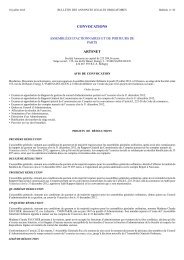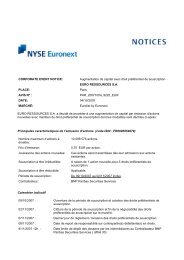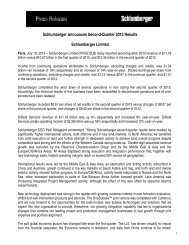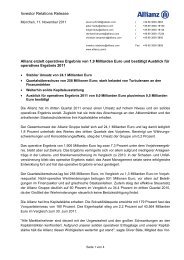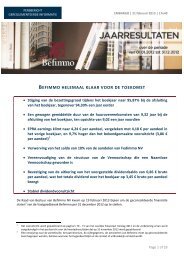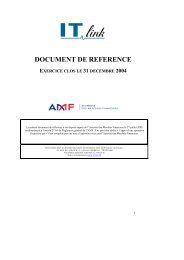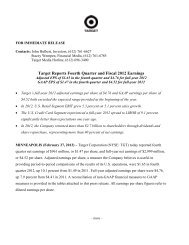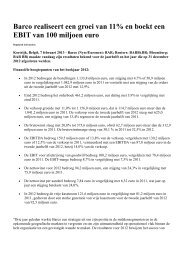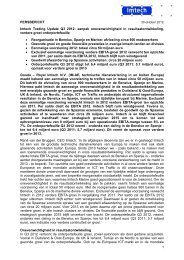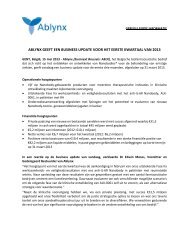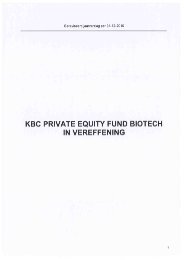FORM 10-Q
FORM 10-Q
FORM 10-Q
Create successful ePaper yourself
Turn your PDF publications into a flip-book with our unique Google optimized e-Paper software.
NOTE 14: FAIR VALUE MEASUREMENTS<br />
Accounting principles generally accepted in the United States define fair value as the exchange price that would be received for an asset or paid to transfer a<br />
liability (an exit price) in the principal or most advantageous market for the asset or liability in an orderly transaction between market participants at the<br />
measurement date. Additionally, the inputs used to measure fair value are prioritized based on a three-level hierarchy. This hierarchy requires entities to<br />
maximize the use of observable inputs and minimize the use of unobservable inputs. The three levels of inputs used to measure fair value are as follows:<br />
• Level 1 — Quoted prices in active markets for identical assets or liabilities.<br />
• Level 2 — Observable inputs other than quoted prices included in Level 1. We value assets and liabilities included in this level using dealer and broker<br />
quotations, certain pricing models, bid prices, quoted prices for similar assets and liabilities in active markets, or other inputs that are observable or can<br />
be corroborated by observable market data.<br />
• Level 3 — Unobservable inputs that are supported by little or no market activity and that are significant to the fair value of the assets or liabilities. This<br />
includes certain pricing models, discounted cash flow methodologies and similar techniques that use significant unobservable inputs.<br />
Recurring Fair Value Measurements<br />
In accordance with accounting principles generally accepted in the United States, certain assets and liabilities are required to be recorded at fair value on a<br />
recurring basis. For our Company, the only assets and liabilities that are adjusted to fair value on a recurring basis are investments in equity and debt<br />
securities classified as trading or available-for-sale and derivative financial instruments. Additionally, the Company adjusts the fair value of long-term debt as<br />
a result of the Company's fair value hedging strategy.<br />
Investments in Trading and Available-for-Sale Securities<br />
The fair values of our investments in trading and available-for-sale securities using quoted market prices from daily exchange traded markets were based on<br />
the closing price as of the balance sheet date and were classified as Level 1. The fair values of our investments in trading and available-for-sale securities<br />
classified as Level 2 are priced using quoted market prices for similar instruments or nonbinding market prices that are corroborated by observable market<br />
data. Inputs into these valuation techniques include actual trade data, benchmark yields, broker/dealer quotes, and other similar data. These inputs are<br />
obtained from quoted market prices, independent pricing vendors or other sources.<br />
Derivative Financial Instruments<br />
The fair values of our futures contracts were primarily determined using quoted contract prices on futures exchange markets. The fair values of these<br />
instruments were based on the closing contract price as of the balance sheet date and were classified as Level 1.<br />
The fair values of our derivative instruments other than futures were determined using standard valuation models. The significant inputs used in these models<br />
are readily available in public markets, or can be derived from observable market transactions, and therefore have been classified as Level 2. Inputs used in<br />
these standard valuation models for derivative instruments other than futures include the applicable exchange rates, forward rates, interest rates and discount<br />
rates. The standard valuation model for options also uses implied volatility as an additional input. The discount rates are based on the historical U.S. Deposit<br />
or U.S. Treasury rates, and the implied volatility specific to options is based on quoted rates from financial institutions.<br />
22



